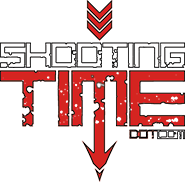As hunters, we need to nab every advantage we can. After all, the animals we want to harvest have been evolving for centuries to survive predators. For all of our technological advancements, we still don’t have the instincts deer, elk, and other creatures do. On top of that, most of our prey are much more active during times when light is scarce or nonexistent. This is where a thermal scope can really make the difference between filling your freezer or not. Let’s take a look at what thermal scopes do, and why you should latch onto this tech. Then we’ll give you some of the best choices for your rifle’s next optic.
What Do Thermal Scopes Really Do?
Night vision scopes have been popular for years, but thermal is completely different. A night vision scope takes existing light and amplifies it. This means, of course, there has to be some source of light. On a clear night, the moon and stars will do the trick. Unfortunately, our fall and winter hunting seasons often have more cloudy nights than clear, so what then?
Some people use IR illuminators, which act like a flashlight for night vision. Even these have their limitations, though. These accessories have their own power needs, so you could find yourself forced to carry around twice the batteries you would otherwise.
Enter the thermal scope. Rather than relying on ambient light, like from the moon or stars, thermal scopes use a totally different spectrum of light: infrared. This means differences in heat. Animals generate heat, and they’re warmer than their surroundings. This allows a thermal scope to help you detect your target from a long ways off, even when there’s no light for a night vision scope to rely on.
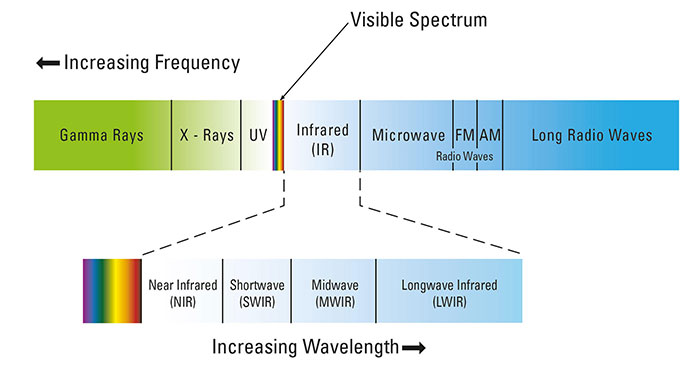
Does That Make a Thermal Scope Better Than Night Vision?
Yes, and no. It’s true that thermal scopes allow you to detect your game in conditions a night vision scope wouldn’t. That’s just part of the picture, though. You also need to be able to recognize and identify the animal.
Thermal scopes display images as back, white, or various shades of color. These colors represent different temperatures. Generally speaking, the hotter the object, the brighter it will appear in your scope. Night vision, because it’s using and amplifying available light, provides you with a picture more like a photograph. Your thermal scope’s image will be a heat map, basically, and you’ll need to train yourself how to tell a deer from another animal using thermal imaging.
One clear advantage of a thermal scope is that you can continue using it even after sunrise. The intensifier tubes inside a night vision scope are easily damaged by bright light, meaning you have to change scopes once the sun comes up. Not so with a thermal scope, since it’s detecting the heat generated by your target and its surroundings.
Another distinct advantage of thermal scopes is how well the hunter can detect game through foliage, cover, or weather conditions that might cloak the target. The thermal scope is able to “see” through crops, rain, fog, and even brush. Very thick objects, like walls or hills, will prevent sighting your target … but that would be the case with night vision, too.
Which Should I Use, Thermal Scopes or Night Vision Scopes?
If you absolutely need some sort of facial recognition or your local deer depredation laws require better identification night vision might be your best bet for harvesting the animal. Thermal will beat out night vision every single time when it comes to detection, but not detailed recognition.
If you regularly hunt in rainy or foggy weather, thermal’s going to be a real ally. It can penetrate the rain or fog, giving you a clear thermal image when a night vision scope would be blinder than a bat.
Furthermore, your thermal scope will be much more helpful when tracking your wounded game than night vision. The animal, and its blood trail, will continue radiating heat for some time. This can mean all the difference between finding the deer you took down a thousand yards away and not. When we head out for coyote hunting or to lower the population of hogs, we prefer thermal scopes over night vision.
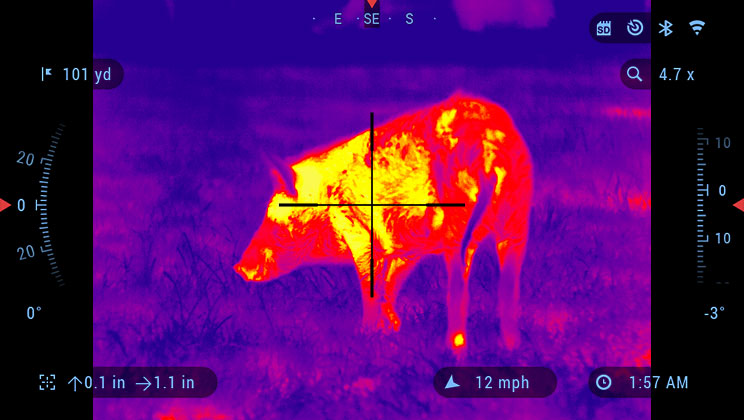
The 5 Best Thermal Scopes for Different Budgets
Here are the best 5 thermal scopes available today. Below this list, you’ll find what we looked for in developing this list so you can make your own choices outside of these, if necessary.
AGM Global Vision Python TS50-640 Thermal Riflescope
The best of the best for most hunting purposes, in our opinion, is the AGM Global Vision Python TS50-640 thermal scope. It comes with a FLiR Tau 2 640×512 thermal sensor, pretty much the gold standard in thermal sensor resolutions. The 50mm lens offers 2X optical magnification, plus the onboard software provides 1X, 2X, 4X, and 8X digital zoom. The 60Hz refresh rate will keep your image in real-time. You can use this scope to detect game out to 1,000 yards and recognize what it is from as far away as 650 yards.
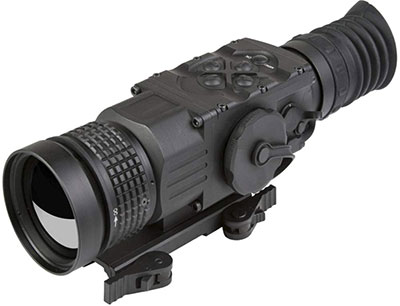
The Python is comfortable in the most extreme weather conditions, from -40ºF to 122ºF. Battery life is short, just 4 hours at 68ºF, but it operates on a pair of small, lightweight CR123A batteries. It also has a microUSB port for connecting to an external battery pack. This guy will set you back almost $6,000, but the quality and capabilities more than make up for that.
ATN Thor 4 Thermal Riflescope
If you want a thermal scope that’s great not only for bagging game but also recording the kill for posterity, the ATN Thor 4 is your scope. Its dual Gen4 sensors operate at resolutions of 384×288 or 640×480, depending on magnification. Refresh rate is a blazing 60Hz, and magnification is available in increments from 1.25-5X clear out to 4-40X depending on which model you buy. The Thor 4 allows you to record video to a micro SD card, and you can also stream your view to an iOS or Android device using the scope’s built-in WiFi.
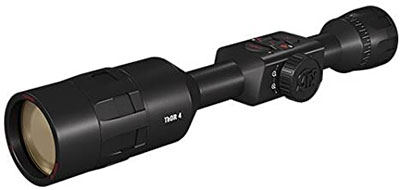
Those features come at a price, of course. The ATN Thor 4 will set you back between $1,900 and $4,800, depending on how much magnification you choose.
Pulsar Core RXQ30V Thermal Riflescope
The Pulsar Core RXQ30V thermal riflescope works perfectly in temperatures from bitter cold to blisteringly hot (-13ºF to 122ºF), and has a frost-resistant 640×480 AMOLED display. Optical magnification from 1.6X to 6.4X should serve most needs, with digital zoom of 2X, 3X, and 4X available to extend your view out even more. Its optimal range is 985 yards, and the 384×288 sensor resolution is almost perfect at that range. The 50Hz refresh rate means your game can be moving fast and you won’t miss a beat.
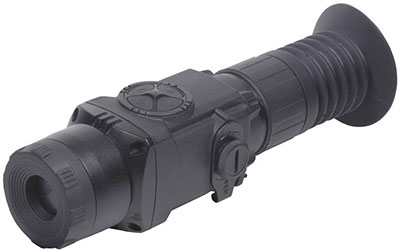
The Pulsar Core RXQ30V is expensive, at almost $2,000, but the features and quality make it worth every penny.
AGM Global Vision Rattler TS25-384 Compact Thermal Riflescope
This compact tactical thermal scope proves great things come in small packages. The AGM Global Vision Rattler TS25-384 is just 7.37 inches long, but offers up to 8X digital zoom with great quality. The OLED display provides 1024×768 resolution, and the advanced FLiR Tau 2 sensor gives you 384×288 resolution. The optic can be used as a riflescope or a handheld monocular, and you can connect any external 5V battery pack via USB to increase operation time. Detection is great with this scope out to 650 yards, and recognition to 350 yards.
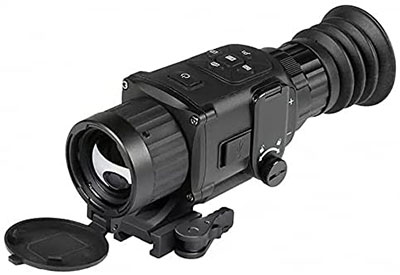
The main drawback with this scope is that the battery only lasts 4.5 hours, so you’ll definitely want to power it off when you aren’t using it. The Rattler works off a pair of CR123 batteries, though, so carrying an extra set won’t weigh you down. The price, though, is a bit steep at $1,985.
ATN Thor LT Thermal Riflescope
Another ATN gem, the Thor LT Thermal Riflescope is our budget pick for a thermal riflescope. This scope can get you going for under $1,000. That will get you 3-6X digital zoom, but with a sensor resolution of just 160×120. The great thing here, though, is the refresh rate: a blazing 60Hz. An extra $500 will get you a 320×240 sensor, if you need it. As priced, this scope will offer you detection range out to 475 yards, with positive identification at 160 yards.
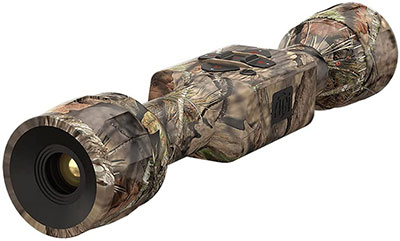
The ATN Thor LT has an operating temperature range great for almost any conditions, from -20ºF to 120ºF. The internal Li-Ion battery is good in the field for about 10 hours.
What Should I Look For in a Thermal Scope?
So, you’ve decided that you want a thermal scope for your rifle. Now the key is picking the best one. We’ve done most of the legwork for you with the recommendations above. Still, you may want to find another option. Here are the factors we looked at when choosing the best thermal rifle scopes.
Magnification, or Zoom
This, you probably already know, is the ability of a scope to enlarge a distant object by magnifying it. Thermal scopes usually provide specific details of their optimal magnification distances. Higher magnification can make the image grainer and refresh slower.
Look for magnification in the 5X to 8X range. Some devices will claim 20X magnification, but that’s going to come at the cost of a very poor-quality final image that you might not be able to recognize.
Type of Zoom
Digital zoom uses software to magnify your image. It’s more affordable, but that comes at a cost: poor image quality that you can’t do anything with. It’s far better to look for optical zoom, which uses a lens and delivers a crisper image.
Refresh Rate
The more frequently your scope refreshes the scene, the more clearly you’ll be able to detect movement. Thermal scopes offer a wide range of refresh rates, from 7.5 to 60Hz. If all you want to do is survey the scene and observe, a lower refresh rate will serve you fine. On the other hand, if you want to take down game that’s on the move, look for a refresh rate of at least 30Hz.
Resolution of the Thermal Scopes and Sensors
Make sure you know the resolution not just of the scope itself, but also the thermal sensor. You will find some scopes that advertise a resolution of 800×600, but the thermal sensor’s resolution is just 320×240. If you get the same scope, but with a 640×480 thermal sensor, your thermal image will be much more clear.
Don’t try nailing down the perfect reading here, though. You can end up overpaying dramatically for a very modest increase in quality. You’ll notice our top pick’s sensor core features a 384×288 resolution; it works splendidly on that scope.
Scope Detection Range
Entry-level scopes will be good for positive detection and identification out to 1,000 yards or less. On the other hand, a very high-quality thermal scope will extend that range out to 4,000 yards.
Typically, the lens diameter and angle of view will have the biggest impact on range. The larger diameter of your lens and the smaller the angle, the longer detection distance you’ll get. Keep in mind your own hunting conditions; if you know you won’t ever try harvesting an animal from more than 2,000 yards, there’s no point in maxing out your scope’s range.
Reticle Pattern
Some may say this is a matter of personal preference. Some scopes just give you a single-dot reticle for pinpoint accuracy, while others will have a 4-line crosshair.
If you’re night-hunting with a thermal scope, a 4-line crosshair is probably going to be more useful. It will help you adjust for range to target, and you don’t necessarily need the pinpoint short-range accuracy of a single-dot reticle.
Battery Life
Pay attention to the details here. Your thermal scope won’t do you any good if the battery dies in the middle of your hunt and you don’t have a spare. At the same time, you won’t want to carry too many extra batteries.
A good thermal scope should be good for at least 7-8 hours on a single charge. Manufacturers might try to fool you here, suggesting the battery will hold its charge for 40 hours or more, but this number is usually standby mode. Actively using the scope will drain the battery much faster.
Warranty
Finally, pay attention to the warranty provided for your thermal scope. These devices are incredibly complex and fragile, and they cost a pretty penny. If you hope to get the most out of your investment, make sure the scope includes a generous warranty length. Also, check reviews for customer support — friendly and competent support is going to be very important, especially if this is your first thermal scope.
Making the Switch to a Thermal Scope for Hunting
Hopefully, you’ve seen the benefit thermal scopes can give you on your next hunt. We’ve provided you a number of excellent choices for your first (or next) thermal scope, and also outlined how to evaluate the product choices yourself.
So, take this information, and go fill that freezer.
